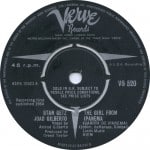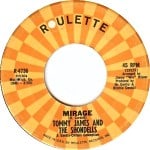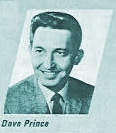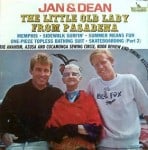Keener Bosa Nova
 In 1964, America’s musical tastes had not yet fully polarized. While the wave of British hits washed over us, there was still an eclecticism to the WKNR play list that made it possible for a jazz legend to link up with a Brazilian samba singer and have a hit record.
In 1964, America’s musical tastes had not yet fully polarized. While the wave of British hits washed over us, there was still an eclecticism to the WKNR play list that made it possible for a jazz legend to link up with a Brazilian samba singer and have a hit record.
Such was the unique story of the Stan Getz / Astrud Gilberto partnership. Getz came into the spotlight in the 1940s as the silky smooth tenor sax player in Woody Herman’s Thundering Herd big band. He was introducing bosa nova to American ears when he teamed up with Gilberto, who was a last minute choice to record the vocals for “The Girl From Ipanema”. Continue reading “Keener Bosa Nova” →
The Flaming Ember
 Here’s a trivia question: What blue-eyed soul band refused to sign with Motown but found fame thanks to three of Motown’s greatest contributors?
Here’s a trivia question: What blue-eyed soul band refused to sign with Motown but found fame thanks to three of Motown’s greatest contributors?
Of course we’re talking about Detroit’s own Flaming Ember. They first recorded for Ric Tic Records in 1967, but when Berry Gordy, Jr. folded Ric Tic into Motown, The Flaming Embers, as they were then known, decided to explore other options.
The label that they ultimately chose was Hot Wax, the brain child of Motown creative geniuses Brian Holland, Lamont Dozier, and Edward Holland, Jr.. They charted six times on Keener with “Mind, Body and Soul”, “Not My Brother’s Keeper”, “Westbound Number 9″,”Shades of Green” and “Sunshine”. Many remember “Westbound Number 9” as their favorite Flaming Ember tune, but it was “Mind, Body and Soul” that was their only Keener Number 1. Continue reading “The Flaming Ember” →
The Beatles Last Public Concert
 By 1969, the fissures in the Beatle brand were widening. All four had individual projects under way. The death of their manager, Brian Epstein, brought them closer than perhaps they wanted to be to the business side of the music. And the group’s artistic visions were diverging. The creation of their final album and the palpable tension that was simmering behind the facade was documented in the film “Let It Be“.
By 1969, the fissures in the Beatle brand were widening. All four had individual projects under way. The death of their manager, Brian Epstein, brought them closer than perhaps they wanted to be to the business side of the music. And the group’s artistic visions were diverging. The creation of their final album and the palpable tension that was simmering behind the facade was documented in the film “Let It Be“.
33 years ago today, the Beatles played what can be defined as their final public performance. The un-announced event happened on the rooftop of Apple Records and probably irritated as many neighbors as it attracted.
The album’s penultimate single, “The Long And Winding Road” peaked at number one on the WKNR Music Guide the week of March 17, 1970.
The History of Detroit Radio
 Keenerfans across Detroit remember the weekend that we switched over to WDRQ to hear Art Vuolo‘s superb “History of Detroit Radio” documentary. From beginning to end, it was a well researched and well crafted tale of the golden age of Detroit Top 40 broadcasting.
Keenerfans across Detroit remember the weekend that we switched over to WDRQ to hear Art Vuolo‘s superb “History of Detroit Radio” documentary. From beginning to end, it was a well researched and well crafted tale of the golden age of Detroit Top 40 broadcasting.
It’s just one of dozens of treasures you’ll find at the re-launched Motor City Radio Flashbacks website. George Griggs and Jim Feliciano are steadily adding to the worlds largest archive of Detroit radio sights and sounds.
Whether or not you were one of the first listeners to The History of Detroit Radio when it first aired, it’s well worth reconnecting with this important dimension of the legend and it’s extended segment on the birth and prime of WKNR.
Eileen and “The New Keener Guy”
 From the fantastic DetroitMemories.com website. Eileen Trombley Glick remembers her first encounter with the new guy at WKNR. Someone from an Ohio radio station named Dick Purtan.
From the fantastic DetroitMemories.com website. Eileen Trombley Glick remembers her first encounter with the new guy at WKNR. Someone from an Ohio radio station named Dick Purtan.
Eileen was looking for an emcee for a charity auction. “Most of my co-workers hadn’t much heard of him (yet), so I offered to make the call and ask if he would consider the honors. Much to my surprise, he agreed right away.”
Number one this week in 1967
 Our look through the Keener 1967 archives continues with two takes on The Buckingham’s most popular record. By the time “The Pulsations” got a job as the house band on WGN’s “All Time Hits” television program, the British Invasion was in full swing. When the show’s producers suggested that the band take on a British name to capitalize on the event, a security guard suggested The Buckinghams.
Our look through the Keener 1967 archives continues with two takes on The Buckingham’s most popular record. By the time “The Pulsations” got a job as the house band on WGN’s “All Time Hits” television program, the British Invasion was in full swing. When the show’s producers suggested that the band take on a British name to capitalize on the event, a security guard suggested The Buckinghams.
What followed was a string of 4 Keener hits, beginning with the Jim Holvay penned “Kind of a Drag“. The song reached number one the week of January 23rd and as the year came to an end, “Kind of a Drag” was the 9th most popular record of 1967.
Holvay had the magic touch and his contributions to “Don’t You Care,” “Hey Baby (They’re Playing Our Song),” and “Susan” kept the Buckinghams on the WKNR Music Guide for the next year and a half.
Three decades later, the band released the “Terra Firma” collection, which included this very listenable a capella version of “Kind of a Drag”.
Welcome Back, Motor City Radio Flashbacks!
 If you’re like us, you were a regular visitor to the Detroit Radio Flashbacks website. With 31 gigs of air checks, music and memories, it was a favorite stop for a taste of Motor City radio history. Now Jim Feliciano is in the process of resurrecting the site with a new name: Motor City Radio Flashbacks.
If you’re like us, you were a regular visitor to the Detroit Radio Flashbacks website. With 31 gigs of air checks, music and memories, it was a favorite stop for a taste of Motor City radio history. Now Jim Feliciano is in the process of resurrecting the site with a new name: Motor City Radio Flashbacks.
The site just went up today, so it will take some time before Jim gets everything in his collection back on-line.
Bookmark mcrfb.com and pass the word!
The “Lost” George Harrison Guitar Solo
From WCBS-FM: George Martin deconstructs the mix of The Beatles “Here Comes the Sun” and discovers a track he had forgotten about. Son Giles and George’s son, Dhani are witnesses.
Question: Would you have put the solo in the final mix, or not?
Mirage
 One notable absence from the WKNR Music Guide is Tommy James’ monster hit, “I Think We’re Alone Now“. Keener didn’t play it because Mrs. Knorr was uncomfortable with the lyrics.
One notable absence from the WKNR Music Guide is Tommy James’ monster hit, “I Think We’re Alone Now“. Keener didn’t play it because Mrs. Knorr was uncomfortable with the lyrics.
She wasn’t alone. The song, written by Ritchie Cordell, author of some of the Shondell’s most successful hits, was witheld from the airwaves at a number of radio stations across the country. Although it’s pretty tame by today’s standards, “Too suggestive” was the common complaint in 1967.
But “I Think We’re Alone Now” did find it’s way to Keener. In Reverse. Late one evening, producer Bo Gentry was experimenting with a tape recorder and played the song backwards. He liked what he heard, and so did the band. Cordell wrote some lyrics and before we knew it, “Mirage” was at number eleven on Keener the week of May 1st 1967.
Ritchie Cordell went on to produce bubble gum hits for Crazy Elephant an 1910 Fruit Gum Company. He had a ten year hiatus from the music business before returning to produce Joan Jett’s “I Love Rock and Roll” album.
He’s one of the few song writers to have one number one follow another. That was the province of the Beatles until Billy Idol’s version of “Mony Mony” replaced Tiffany’s cover of “I Think We’re Alone Now” in 1987.
Hear the Shondells sing “Mirage”, along with it’s inspiration, played backwards here.
Aircheck of the Week: Dave Prince
 Remember Sangoo? That was the nick name we associated with Dave Prince during his reign as the evening ace on WKMH. This 1962 aircheck from the Bob Green Collection gives you a great feel for the pre-Keener sound. Juxtapose it with last week’s Gary Stevens aircheck and take note of the differences. For one, you’ll hear Ernie Harwell’s voice promoting Tiger Baseball. Fred Knorr was part owner in those days and before Keener, WKMH was the broadcast home of the Tigers. You’ll notice that when Keener exploded on the scene, the focus was definitely on the music as opposed to the jingles, which got much shorter. The overall energy of the announcers turned up about three notches and there was a total emphasis on listener involvement in the fun.
Remember Sangoo? That was the nick name we associated with Dave Prince during his reign as the evening ace on WKMH. This 1962 aircheck from the Bob Green Collection gives you a great feel for the pre-Keener sound. Juxtapose it with last week’s Gary Stevens aircheck and take note of the differences. For one, you’ll hear Ernie Harwell’s voice promoting Tiger Baseball. Fred Knorr was part owner in those days and before Keener, WKMH was the broadcast home of the Tigers. You’ll notice that when Keener exploded on the scene, the focus was definitely on the music as opposed to the jingles, which got much shorter. The overall energy of the announcers turned up about three notches and there was a total emphasis on listener involvement in the fun.
Perhaps the biggest revelation is how good Dave sounds. He executes the WKMH format well, is clearly having fun and makes for an entertaining and surprisingly listenable sound. Tighten the playlist, turn the focus on the music, shorten the jingles and Sangoo would fit just fine into the Keener vibe. Dave would continue to shine on the Detroit airwaves at WXYZ and CKLW.
The Little Old Lady From Pasadena
 Every now and then an idea and an individual collide to create an icon. In 1984 Clara Peller propelled Wendy’s to the front of our consciousness when she asked, “Where’s the Beef?” Twenty years earlier, a 72 year old character actress was the inspiration for a top 10 smash for Jan & Dean.
Every now and then an idea and an individual collide to create an icon. In 1984 Clara Peller propelled Wendy’s to the front of our consciousness when she asked, “Where’s the Beef?” Twenty years earlier, a 72 year old character actress was the inspiration for a top 10 smash for Jan & Dean.
In the mid 1950s, Kathryn Minner and her husband, Sam, followed their son from New Jersey to Southern California when his insurance job transferred him there. in 1957, at age 65, she made her first television appearance in the “Big Switch” episode of Dragnet. For the next decade, she played the archetypical little old lady in a wide array of television and movie assignments from “I Spy” and “The Man from U.N.C.L.E” to Disney’s “Love Bug”. She came into her acting prime in the wake of a series of ten TV commercials for the Southern California Dodge Dealers, promoting their popular muscle cars with the tag line, “Put a Dodge in your garage, honey!”
 It was the era of the hot rod and when Brian Wilson needed to add authenticity to his automotive lyrics, he turned to future KHJ Boss Jock Roger Christian. Together, they crafted “Ballad of Ole’ Betsy”, “Car Crazy Cutie”, “Cherry, Cherry Coupe”, “Don’t Worry Baby”, “In the Parkin’ Lot”, “Little Deuce Coupe”, “No-Go Showboat”, “Shut Down” and “Spirit of America.”
It was the era of the hot rod and when Brian Wilson needed to add authenticity to his automotive lyrics, he turned to future KHJ Boss Jock Roger Christian. Together, they crafted “Ballad of Ole’ Betsy”, “Car Crazy Cutie”, “Cherry, Cherry Coupe”, “Don’t Worry Baby”, “In the Parkin’ Lot”, “Little Deuce Coupe”, “No-Go Showboat”, “Shut Down” and “Spirit of America.”
But Christian didn’t just write for the Beach Boys. The Wilsons were early supporters of the duo of Jan Berry and Dean Torrence, sometimes appearing on double-bills and covering one another’s hits. Christian’s pen contributed to six Jan and Dean hits, including their two biggest, “Dead Man’s Curve” and “The Little Old Lady From Pasadena”.
Christian was inspired by Minner’s Dodge commercials and, writing with Jan Berry, put her character on a hit record. “The Little Old Lady From Pasadena” peaked at number three on the Billboard charts. It became Keener’s Key Song of the Week on June 11, 1964, climbing to number eleven on the 2nd of July. A Beach Boy cover version appears on their “Beach Boys Concert” LP.
Minner continued to work prolifically until her death on May 28, 1969. Her final role was in the Andy Griffith vehicle, “Angel In My Pocket“. But her spirit lives every time we take out the Liberty Records 45 that she helped to create.
Do You Miss Dick Purtan?
 We do! If there ever was a personality who played ringmaster to the soundtrack of our lives, it was Dick Purtan. From the day he came to WKNR until his retirement from WOMC, he made more people laugh and probably raised more money for good causes than any other radio personality of the day.
We do! If there ever was a personality who played ringmaster to the soundtrack of our lives, it was Dick Purtan. From the day he came to WKNR until his retirement from WOMC, he made more people laugh and probably raised more money for good causes than any other radio personality of the day.
Dick may be retired, but he’s still entertaining. His website, DickPurtan.com features regular podcasts with Dick and his team, commenting on the passing scene with the same smart, acerbically funny vibe that we know and love.
Join his growing legion of on-line fans at DickPurtan.com. And listen to classic Keener Purtan in our Aircheck Archive.

